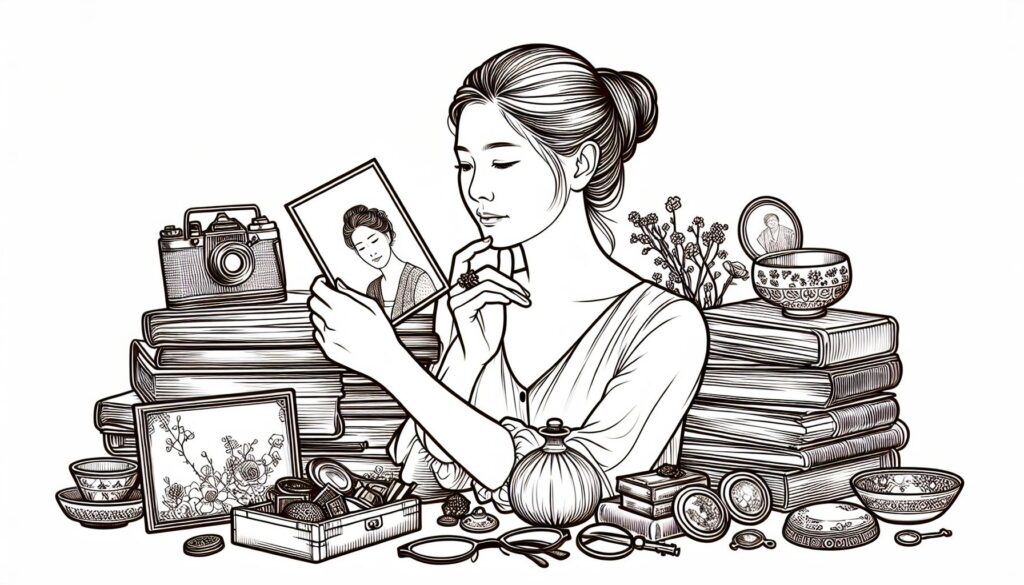We’ve all been there. You’re knee-deep in old mementos and keepsakes, unsure of what to keep and what to let go. Decluttering sentimental items isn’t easy, but it’s essential for maintaining a clean, organized home.
I’ve learned that the key is to balance the emotional value of these items with the practicality of keeping them. It’s not about discarding memories, but about making room for new ones.
In this article, I’ll share some tried and true tips for decluttering sentimental items. These strategies have helped me navigate the tricky waters of sentimental clutter, and I’m confident they can do the same for you.
Assessing the Emotional Value
One of the most challenging aspects of decluttering sentimental items is determining their emotional value. This isn’t an easy task because it involves delving right into an array of feelings attached to those items.
Remember, not all kept items hold the same level of sentimental value. Some belongings might serve as a keynote to a critical chapter of your life, while others may just represent a hazy memory. It’s crucial to distinguish between the two when deciding what to keep and what to let go.
The first step in this process should involve taking an inventory of all your sentimental items. A complete, comprehensible list can provide clarity about the size of the task you’re facing. You don’t need to make any decisions at this stage; it’s just a case of acknowledging what you own.
Here’s a simplified layout of what your inventory could look like:
| Item | Description | Emotional Value |
|---|---|---|
| Old Photo Album | Photos from college years | High |
| Broken Vase | from Great Aunt Mildred | Low |
| Baseball Cap | First baseball game with dad | Medium |
Once the inventory is ready, it’s time to rank the items based on their emotional value. This is a personal process and can vary greatly from person to person. Remember: be patient with yourself and take all the time you need. After all, it’s not a race but a journey.
Consider those items that take you on a walk down memory lane, ignite intense feelings, or represent significant milestones as high-value items. These are your treasures, the things you’d want to hold onto.
As you meticulously went through the process, you’d find some items with little to no emotional investment. These fall into the low-value category. While they might have been part of your life story, their role has now become trivial. It’s these artifacts that you might consider letting go.
Keep in mind, every object in your space claims your time, attention, and energy. So, being ruthless and objective about what truly matters can help you claim that back. The big picture here is to find the right balance between cherishing the past and making room for the future.
Establishing Clear Criteria
Crafting a concrete set of guidelines for deciding what stays and what goes is crucial in the decluttering process. Otherwise, the task of sorting through countless sentimental items can be overwhelming. So, how exactly can you determine which items truly deserve a place in your home and life?
Start with a detailed inventory of all your sentimental items. This step was discussed in the previous section, where we looked at the importance of identifying and ranking items based on their emotional significance to you. Let’s dig a little deeper now.
In your inventory, for each item, identify:
- Its origin
- Its emotional weight
- How frequently it’s used or appreciated
These data will form the backbone of your decision-making process. As you might expect, items that stem from important life events or relationships, carry heavy emotional weight, and are used or appreciated regularly, rank higher on the ‘keep’ spectrum.
Here is a sample markdown table to visualize the ranking process:
| Item | Origin | Emotional Weight | Frequency of Use |
|---|---|---|---|
| Grandma’s necklace | Heirloom | High | Weekly |
| Old concert ticket stub | Friend’s concert | Medium | Never |
| Birthday card from last year | Co-worker | Low | Never |
The highest-ranked items in your inventory serve as your emotional anchors, playing a crucial role in your life story. Preserve these carefully.
Nonetheless, don’t rush the process. Patience is key. It bears repeating that decluttering sentimental items is less about the quantity of items you let go and more about the quality and relevance of those you decide to keep.
Sorting into Categories
Moving onto the next step, it’s now time to be more practical with our process. Sorting into Categories takes the effort we’ve put into creating our sentimental inventory and simplifies it down to a manageable task where we can assess each item’s future place in our life.
Splitting your sentimental items into different groups is cool. You could opt for categories such as:
- Photographs and keepsakes: This can include anything from old birthday cards, letters, diaries to photos.
- Trophies and awards: Your old soccer trophies, academic medals, or even a well-earned employee of the month certificate.
- Heirlooms and antiques: This can span generations – from grandma’s tea set to an old pocket watch.
- Gifts: Anything gifted that holds emotional value, regardless of who the giver was.
By clearly dividing items, you’ll be able to view each category as a separate entity and give each the proper attention it deserves.
Let’s not forget the need for patience as mentioned earlier. Rushing through this phase can result in undesired outcomes. There might be situations where something could fit into multiple categories. For example, a music box might be an heirloom as well as a gift. It’s okay to create a separate category for such items or put them in both. Just take your time and ensure you’re mentally prepared for this operation.
It’s time to Share Your Story. Engage friends, family, or a decluttering consultant and have them participate in your decluttering journey. Sorting out sentimental items isn’t just about getting rid of things. It’s also running a trip down memory lane, enjoying the nostalgia, and possibly learning something new about yourself.
So take a deep breath, it’s time to dive into the past with an organized outlook.
Display vs. Storage
After sorting through your sentimental items, you’ll be faced with an important decision: what do you display and what do you store? This is a significant step in the decluttering process. But don’t be discouraged, I’m here to guide you through.
Deciding what to display should be influenced by the personal value an item holds and how often you want to see or use it. Moreover, the item’s condition and size should be considered. Do you have an old, hand-knitted scarf from your grandmother? Don’t bury it in a box; wear it, or put it on display. Remember, display means appreciation. Items that evoke strong feelings of nostalgia or happiness are perfect candidates for your displaying area.
Onto items reserved for storage. What makes an item worth storing? The primary reason would typically be long-term sentimental worth. For example, childhood keepsakes or generational family heirlooms. While these may not be items you need to see daily, they are the ones you cannot bring yourself to part with. So, designate a specific, manageable space for storage. Stick to this boundary to avoid turning your storage into a dumping ground for clutter.
Translate these principles into an organized system. For instance, assign different spaces in your home for display and storage. High traffic areas like the living room could be perfect for display items, while a closet shelf or under-the-bed storage boxes can be set aside for those sentimental items you want to keep but don’t need to see daily.
Through this method, objects of emotional value will become integrated into your space rather than contributing to clutter. And while you’re at it, you’ll be creating a carefully curated, meaningful environment.
With the right approach, balance can be achieved between honoring your sentiments and maintaining an uncluttered space. In the next section, we’ll dive into specific ways to display and store these items. It’s all about blending functionality with sentiment.
Letting Go with Gratitude
Are you finding it hard to let go of those sentimental items? I feel you. Letting go is an emotional process but here’s a technique that could guide you—Greet, Gratitude, and Goodbye.
Greet: Yes, talk to the item! Remember, these items are not just “things.” These are carriers of emotions, memories, experiences. Greet them and acknowledge their presence.
Gratitude: Express gratitude. Maybe it’s a book that opened new perspectives, perhaps it’s your grandma’s locket that’s been with you during tough times. Express your appreciation and articulate those feelings. You might not realize this yet, but articulation has a profound effect.
A quick example:
“Dear grandma’s locket, thank you for giving me strength during those lonely college days. You were a beautiful reminder of my grandma’s love.”
Goodbye: Often, people find this step hardest. You’re not alone. Remember, saying goodbye doesn’t mean you’re erasing memories. You still have those. You’re letting go of the physical form, making room for new experiences, new memories.
Let’s not underestimate the emotional toll this process can take. Here’s an Emotional Strength Scale to help you gauge where you’re at and whether you’re ready to let go just yet.
| Emotional Level | Description |
|---|---|
| 1 – Relief | Ready to let go, no tension noted |
| 2 – Uncomfortable | Some discomfort but manageable |
| 3 – Struggling | Not quite ready, substantially overwhelmed |
Work in your comfort zone, don’t rush. Walk this path at your own pace.
Sounds too simple? Doesn’t seem to fit you? Don’t worry. There’s no one-size-fits-all solution when it comes to decluttering sentimental items. Experiment with various approaches – who knows, it might be a combination of techniques that works best for you. We’ll continue exploring more ways to declutter in the next section.
Key Takeaways
- Decluttering sentimental items is a delicate process that requires balancing emotional values with practicality. It’s about making room for new memories, not discarding old ones.
- Start the decluttering process by assessing the emotional value of your items. Understand that not all items hold equal sentimental value. Create a comprehensive list and rank the items based on their emotional significance.
- Establish clear criteria for deciding what stays and what goes. Identify the origin of each item, its emotional weight, and how frequently it’s used or appreciated.
- Sort your sentimental items into categories such as photographs & keepsakes, trophies & awards, heirlooms & antiques, and gifts. By dividing items, you’ll be able to give each category the proper attention it deserves.
- After sorting, decide what you want to display and what to store. Items of strong personal value or that evoke strong feelings of nostalgia or happiness are great for display, while others with long-term sentimental worth can be put to storage.
- Practice the Greet, Gratitude, and Goodbye technique for letting go of sentimental items with gratitude. Acknowledge their presence, express your appreciation, and say goodbye. Remember that saying goodbye to physical items doesn’t mean erasing memories.
Conclusion
Letting go of sentimental items isn’t easy, but it’s doable. With the Greet, Gratitude, and Goodbye technique, you can honor your emotions and memories while decluttering. Remember, the Emotional Strength Scale is there to guide you, not pressure you. You’re in control of your decluttering journey. There’s no one-size-fits-all method, so feel free to mix and match techniques until you find what works best for you. The key is to move at a pace that feels right. Remember, it’s not about the physical items, but the memories they hold. Those will always be with you, even after the decluttering is done. So, here’s to a clutter-free space that breathes positivity and tranquility.
What is the Greet, Gratitude, and Goodbye technique?
This is a technique suggested to address the emotional challenge of decluttering sentimental items. It involves acknowledging the item’s emotional value, expressing gratitude for its significance, and saying goodbye to its physical form while retaining the memory.
What is the Emotional Strength Scale?
The Emotional Strength Scale in the article is a tool to help individuals assess their readiness to part with sentimental items. This can aid in understanding emotional connections and guiding the decluttering process.
Why is it important to work at one’s own pace in decluttering?
Working at one’s own pace is emphasized because decluttering is a personal process that should not be rushed. It is important to handle emotions and move forward when one feels ready.
Does the article suggest a universal decluttering solution?
No, the article highlights that there is no one-size-fits-all solution. It encourages experimenting with different decluttering approaches to find the one that works best for the individual.
What can be expected in the upcoming sections of the article?
The upcoming sections of the article will explore further decluttering methods. It aims to equip readers with a range of strategies to make the decluttering process smoother and more effective.



